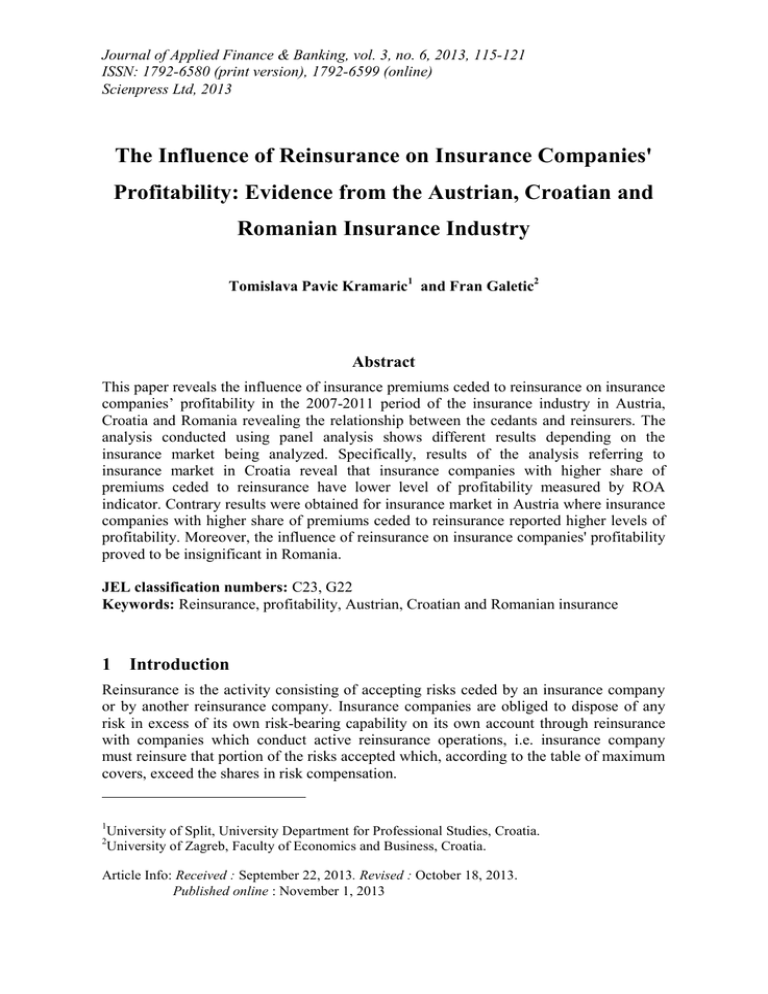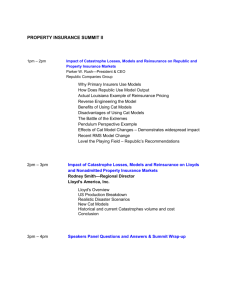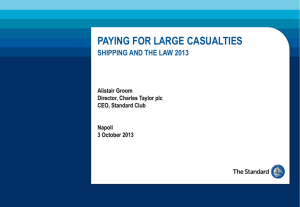Document 13727846
advertisement

Journal of Applied Finance & Banking, vol. 3, no. 6, 2013, 115-121 ISSN: 1792-6580 (print version), 1792-6599 (online) Scienpress Ltd, 2013 The Influence of Reinsurance on Insurance Companies' Profitability: Evidence from the Austrian, Croatian and Romanian Insurance Industry Tomislava Pavic Kramaric1 and Fran Galetic2 Abstract This paper reveals the influence of insurance premiums ceded to reinsurance on insurance companies’ profitability in the 2007-2011 period of the insurance industry in Austria, Croatia and Romania revealing the relationship between the cedants and reinsurers. The analysis conducted using panel analysis shows different results depending on the insurance market being analyzed. Specifically, results of the analysis referring to insurance market in Croatia reveal that insurance companies with higher share of premiums ceded to reinsurance have lower level of profitability measured by ROA indicator. Contrary results were obtained for insurance market in Austria where insurance companies with higher share of premiums ceded to reinsurance reported higher levels of profitability. Moreover, the influence of reinsurance on insurance companies' profitability proved to be insignificant in Romania. JEL classification numbers: C23, G22 Keywords: Reinsurance, profitability, Austrian, Croatian and Romanian insurance 1 Introduction Reinsurance is the activity consisting of accepting risks ceded by an insurance company or by another reinsurance company. Insurance companies are obliged to dispose of any risk in excess of its own risk-bearing capability on its own account through reinsurance with companies which conduct active reinsurance operations, i.e. insurance company must reinsure that portion of the risks accepted which, according to the table of maximum covers, exceed the shares in risk compensation. 1 2 University of Split, University Department for Professional Studies, Croatia. University of Zagreb, Faculty of Economics and Business, Croatia. Article Info: Received : September 22, 2013. Revised : October 18, 2013. Published online : November 1, 2013 116 Tomislava Pavic Kramaric and Fran Galetic According to the [1] reinsurance is a major financial activity as it allows direct insurance companies, by facilitating a wider distribution of risks at worldwide level, to have a higher underwriting capacity to engage in insurance business and provide insurance cover and also to reduce their capital costs; furthermore, reinsurance plays a fundamental role in financial stability, since it is an essential element in ensuring the financial soundness and the stability of direct insurance markets as well as the financial system as a whole, because it involves major financial intermediaries and institutional investors. For example, [2] stipulates that reinsurance business constitutes the conclusion and execution of reinsurance contracts, whereby the risk in excess of the retention of an insurance company is transferred to a reinsurance company, that is, the activities involving acceptance of the risks ceded by an insurance company. Moreover, according to [3] the insurance companies calculate retention levels in tables of maximum coverage taking account of the total volume of business, insurance premium written for each insurance class, results equalisation, the amount of capital and capital adequacy, return on capital, the probability of a loss event having regard to the structure of the insurance company’s portfolio, the amount of loss, business policy of the insurance company. According to the data from the [4] global premium volume in 2010 amounted to US $ 4,338 billion while 9% of it relating to non-life insurance business was ceded to reinsurance and only 2% of total premium relating to life insurance was ceded to reinsurers pointing out that the reinsurance sector is small compared to the primary insurance sector. However, as stated in [4], reinsurance is an integral part of the insurance market and plays the vital role regarding the financial stability of the global insurance markets. Since the reinsurance is not widely investigated topic except in terms of financial stability we wanted to test the influence of the premiums ceded to reinsurance on insurance companies' profitability measured by ROA indicator. The influence of this variable on insurers' profitability is somewhat ambiguous, i. e. it may depend on different facts. One may suggest that insurance companies which tend to cede higher shares of premiums to reinsurance have worse performance since they are, in that way, losing part of their income. This might be true for smaller or undeveloped insurance markets with activities limited to national boundaries and not exposed to the impact of severe losses. This can describe, for example, insurance markets in Croatia or Romania. However, developed insurance markets with companies that are conducting insurance business across many countries, especially in the regions with high risk accumulation see reinsurance as a tool for better risk diversification mitigating in that way potential losses. An example of such a market can be insurance market in Austria. Therefore, we have decided to conduct our analysis on the sample of three countries: Austria - representing old EU member state with well developed insurance market, Romania - new EU member state and Croatia - latest EU member state with relatively small and undeveloped insurance markets, but with great potentials for growth. This paper consists of four sections. The first section refers to the introductory remarks. Basic characteristics of insurance markets in the observed countries are given in the third section, while the fourth section deals with the empirical analysis. In the final section conclusions are drawn. The references follow after the concluding remarks. Reinsurance on Insurance Companies' in Austria, Croatia and Romania 117 2 Basic Characteristics of Insurance Markets in the Observed Countries These countries encompassed by the analysis represent the old and the new EU member states, whilst Croatia is latest EU member. Therefore, their insurance markets also differ which can be seen from the tables below. Table 1: Total premiums' market share by country in the 2007-2011 period Country/Year 2007 2008 2009 2010 2011 AUSTRIA 1.3% 1.5% 1.5% 1.5% 1.5% CROATIA 0.1% 0.1% 0.1% 0.1% 0.1% ROMANIA 0.2% 0.2% 0.2% 0.2% 0.2% Source: [5] Austrian insurance market comprises 1.5% of the total European market, while Croatian and Romanian insurance market have 0.1% and 0.2% share respectively. However, the differences between these countries are more noticeable when observing the level of insurance market development indicators. The most common used insurance market development indicators are premiums per inhabitant as well as the premiums to GDP ratio shown in Tables 2 and 3. These indicators suggest significant differences between the observed countries suggesting higher level of development of the Austrian insurance market. According to the levels of both development indicators shown here Croatian insurance market is significantly below the EU average while the Romanian insurance market performed even worse. Table 2: Average total premiums per capita in the 2007-2011 period Country/Year 2007 2008 2009 2010 2011 AUSTRIA 1.916 1.949 1.965 1.999 1.958 CROATIA 278 302 289 287 279 ROMANIA 94 113 84 92 86 Source: [5] Table 3: Total premiums to GDP ratio in the 2007-2011 period Country/Year 2007 2008 2009 2010 AUSTRIA 5.8% 5.7% 5.9% 5.8% CROATIA 2.8% 2.8% 2.9% 2.8% ROMANIA 1.6% 1.7% 1.5% 1.6% Source: [5] 2011 5.5% 2.7% 1.4% Figure 1 shows the share of total premium ceded to reinsurance in all three observed countries in the 2007-2011 period. Among the observed countries Croatia is the one with the lowest share of premiums ceded to reinsurance. Austria shows a steady trend with a share of premiums ceded to reinsurance ranging between 17.63% and 19.50%. The dynamics of the share of reinsurance premium in total premium in Romania has been uneven, i. e. in the first three years Romanian insurance companies ceded the highest amount of total premiums to reinsurance, though in the last two years of the observed period this trend has slowed down. 118 Tomislava Pavic Kramaric and Fran Galetic 30,00 25,00 24,04 20,59 22,88 19,50 20,00 19,46 17,63 18,42 17,76 17,83 15,00 Romania 15,31 10,00 Croatia 10,85 9,82 10,33 2007 2008 2009 Austria 11,63 11,54 2010 2011 5,00 0,00 Figure 1: The Share of Reinsurance in Total Premium Source: authors’ calculation based on the data from [6], [7] and [8] 3 Empirical Analysis Important question when it comes to the observed three countries according to the influence of reinsurance on insurance companies' profitability is whether there is a similar trend in each country. The authors tried to answer this question using the panel analysis, which analyzes, according to [9] and [10], the temporal and special dimension simultaneously. Therefore, the following model is developed: ROA = c(1)*SHA_RE where ROA (return on assets) denotes the level of profitability and SHA_RE refers to the share of premium cede to reinsurance. The results of the empirical analysis referring to the insurance market in Croatia are contained in Table 4. As shown in Table 4, estimated parameters in the model were significant at the level of 10%. The level of significance of 10% was chosen according to [11] and [12]. Moreover, variable share of reinsurance in total premium has negative and statistically significant influence on insures’ profitability. According to this, the increase in premiums ceded to reinsurance decreases the insurers' profitability. More specifically, the increase of premiums ceded to reinsurance by 1% decreases the insurers' profitability measured by ROA indicator, by 0,080. Similar findings were obtained in [13] and [14]. Reinsurance on Insurance Companies' in Austria, Croatia and Romania 119 Table 4: Parameter estimates of dynamic panel model for Croatia Dependent Variable: ROA Method: Panel Least Squares Sample: 2007 2011 Periods included: 5 Cross-sections included: 26 Total panel (unbalanced) observations: 115 Variable Coefficient Std. Error t-Statistic Prob. SHA_RE -0.080761 0.042430 -1.903424 0.0595 R-squared Adjusted R-squared S.E. of regression Sum squared resid Log likelihood Durbin-Watson stat -0.066701 -0.066701 7.847784 7020.999 -399.6023 0.194681 Mean dependent var S.D. dependent var Akaike info criterion Schwarz criterion Hannan-Quinn criter. -2.399565 7.598460 6.966997 6.990866 6.976685 Source: Authors` calculations The results of the empirical analysis of the influence of the premiums ceded to reinsurance on profitability of Austrian insurance companies are shown in Table 5. All estimated parameters in the model are significant suggesting the suitability of the model. Contrary to the results obtained for Croatia, here we have obtained positive signed of the share of reinsurance in total premium variable indicating that insurance companies which cede higher shares of premiums to reinsurance are more profitable. The increase of shares of premiums ceded to reinsurance by one percent will increase the insurers' profitability on the average by 0,039. Table 5: Parameter estimates of dynamic panel model for Austria Dependent Variable: ROA Method: Panel Least Squares Sample: 2007 2011 Periods included: 5 Cross-sections included: 52 Total panel (balanced) observations: 260 ROA=C(1)*SHA_RE C(1) R-squared Adjusted R-squared S.E. of regression Sum squared resid Log likelihood Durbin-Watson stat Source: Authors` calculations Coefficient Std. Error t-Statistic Prob. 0.039221 0.006131 6.397272 0.0000 -0.047128 -0.047128 3.142973 2558.475 -666.1670 0.898757 Mean dependent var S.D. dependent var Akaike info criterion Schwarz criterion Hannan-Quinn criter. 1.413423 3.071431 5.132054 5.145749 5.137560 120 Tomislava Pavic Kramaric and Fran Galetic The results of the empirical analysis of the influence of the share of premiums ceded to reinsurance on insurance companies' profitability in Romania can be seen in Table 3. Contrary to the results obtained for insurance markets in Croatia and Austria, the model showed the insignificance of this variable on insurers' profitability (p=0,9572). According to the results, it seems that the share of reinsurance in total premium variable doesn’t influence on insurance companies' profitability in Romania. i. e. the insignificant value of this variable suggests that the influence of reinsurance on insurance companies' profitability hypothesis can be rejected. Table 6: Parameter estimates of dynamic panel model for Romania Dependent Variable: ROA Method: Panel Least Squares Sample: 2007 2011 Periods included: 5 Cross-sections included: 56 Total panel (unbalanced) observations: 211 Variable Coefficient Std. Error t-Statistic Prob. SHA_RE -0.000710 0.013225 -0.053707 0.9572 R-squared Adjusted R-squared S.E. of regression Sum squared resid Log likelihood Durbin-Watson stat -0.043098 -0.043098 28.62712 172097.6 -1006.664 2.066376 Mean dependent var S.D. dependent var Akaike info criterion Schwarz criterion Hannan-Quinn criter. -5.806066 28.02949 9.551314 9.567200 9.557736 Source: Authors` calculations 4 Concluding Remarks Reinsurance plays a vital role in financial stability since it allows direct insurance companies, by facilitating a wider distribution of risks at worldwide level, to have a higher underwriting capacity to engage in insurance business and provide insurance cover. Reinsurance operations ensure the stability of direct insurance markets as well as the financial system as a whole, because it involves major financial intermediaries and institutional investors. Therefore, the authors tried to explore how reinsurance affected profitability of insurance markets in Austria, Croatia and Romania in the five year period. These countries were chosen due to the fact that they represent group of underdeveloped as well as the group of developed insurance markets and, of course, due to the data availability. The results of the analysis vary depending on the country being subject of investigation. The relationship between direct insurers and reinsurers in Croatia proved to be significant and negative indicating that insurance companies with higher share of premiums ceded to reinsurance have lower level of profitability. This is in accordance with the assumption that smaller or undeveloped insurance markets with activities limited to national boundaries which not exposed to the impact of severe losses cede lower shares of premiums to reinsurance. Reinsurance on Insurance Companies' in Austria, Croatia and Romania 121 However, contrary results were obtained for insurance market in Austria where insurance companies with higher share of premiums ceded to reinsurance reported higher levels of profitability. This is in accordance with the explanation that developed insurance markets with companies that are conducting insurance business across many countries, especially in the regions with high risk accumulation see reinsurance as a tool for better risk diversification mitigating in that way potential losses. References [1] [2] [3] [4] [5] [6] [7] [8] [9] [10] [11] [12] [13] [14] Croatian Insurance Act (Official Gazette 151/05, 87/08, 82/09, 54/13), [16/08/2013] EU DIRECTIVE 2005/68/EC OF THE EUROPEAN PARLIAMENT AND OF THE COUNCIL on reinsurance: http://eur-lex.europa.eu/LexUriServ/site/en/oj/2005/l_323/l_32320051209en000100 50.pdf [10/09/2013] Ordinance on the methodology for the calculation of insurance companies’/ reinsurance companies’ retention levels in tables of maximum coverage and on the calculation of maximum probable loss (Official Gazette 100/09), http://www.hanfa.hr/getfile/39658/5_4_17_ic.pdf [01/09/2013] IAIS (International Association of Insurance Supervisors). (2012) Reinsurance and Financial Stability. Basel. Available at: http://www.iaisweb.org/ Insurance Europe: http://www.insuranceeurope.eu/facts-figures/statistical-series/total-business [03/09/2013] http://www.ripe.hanfa.hr/hr/publiciranje/osiguravajuca-drustva/[01/07/2013] https://www.fma.gv.at/en/statistics-reporting/statistics-companies/insurance-underta kings/austrian-insurance-statistics.html [03/05/2013]. http://www.csa-isc.ro/index.php?option=com_content&view=article&id=70&Itemid =77&lang=en [15/06/2013] P. K. Watson and S. S. Teelucksingh, A practical introduction to econometric methods: classical and modern, University of the West Indies Press, Kingston, 2002. J. H. Stock and M. W. Watson, Introduction to Econometrics, Addison Wesley, 2006. I. Šošić, Pregled formula iz statistike, Školska knjiga, Zagreb, 2006. G. S. Maddala, Introduction to Econometrics, Wiley, West Sussex, 2006. H.-H. Lee and C.-Y. Lee, An Analysis of Reinsurance and Firm Performance: Evidence from the Taiwan Property-Liability Insurance Industry, The Geneva Papers on Risk and Insurance - Issues and Practice 37, (July 2012), pp. 467-484 O. Olaosebikan, The Determinants of the Profitability of Micro-Life Insurers in Nigeria, The Geneva Papers 38, (2013), pp. 140–159





